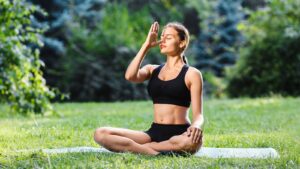It was said above that the autonomic nervous system works independently of our will. But there is one bodily function that can serve as a bridge between the autonomic nervous system and our will center. This is breath.
Breathing is usually controlled by the autonomic nervous system involuntarily, but we also have the ability to consciously control the breathing muscles. Breathing is the point of contact of the conscious and unconscious work of the body. And breathing will help us gain control over the sympathetic and parasympathetic systems.
The practice of yoga https://www.julianalucky.com/post/mommy-and-me-yoga-benefits, pranayama, and muscle stretching stimulate the vagus nerve, which is the main component of the parasympathetic nervous system. With regular practice, stress levels will decrease and health will improve.
Belly breathing (abdominal breathing)
– Lie on your back so that gravity does not interfere with the movement of the diaphragm. Close your eyes.
– Wait until the breath calms down and comes to a normal pace and depth.
– Focus on the area below the navel.
– Take a slow deep breath, relaxing and expanding the stomach. Feel your belly expand outwards and down at the same time. Notice the sensation as if the air you are breathing is pressing against your perineum. Don’t stress.
– While exhaling, pull the navel to the back and up. The chest is still and relaxed.
You can help yourself by placing one hand on your stomach and the other hand on your chest. When inhaling, the hand above the navel should rise up to the ceiling. When exhaling, it should go down. Control the chest with the other hand. She must remain still and relaxed.
Chandra Nadi pranayama or lunar breathing
– Sit in a sitting posture with a straight back, keep your head and neck straight as well. Padmasana, vajrasana or sukhasana are well suited for this practice. You can also just sit in a chair with a straight back and relaxed shoulders.
Close the right nostril with the thumb of the right hand. Inhale slowly and silently through the left nostril to a count of 5.
Close the left nostril with the ring finger of the right hand and at the same time open the right nostril. Exhale slowly and silently to the count of 5.
This is one breath cycle. Perform pranayama for 3 minutes, gradually increasing the duration of the session to 10 minutes every day.
Kaki Mudra Pranayama (Crow’s Beak Breathing)
– Sit in the meditative pose of Padmasana, Sukhasana or Vajrasana. Place your hands on your knees in Chin Mudra.
-Pull out your lips with a tube, focus on the tip of your nose.
– Slowly take a deep breath through your mouth (mouth tube)
-Pinch your lips and exhale slowly through your nose.
This exercise affects the sensations of the tongue and the inside of the mouth, which are innervated by the vagus nerve, favoring parasympathetic activity.
This cooling pranayama is ideal for hot weather when excessive sympathetic activity manifests itself as sweating.